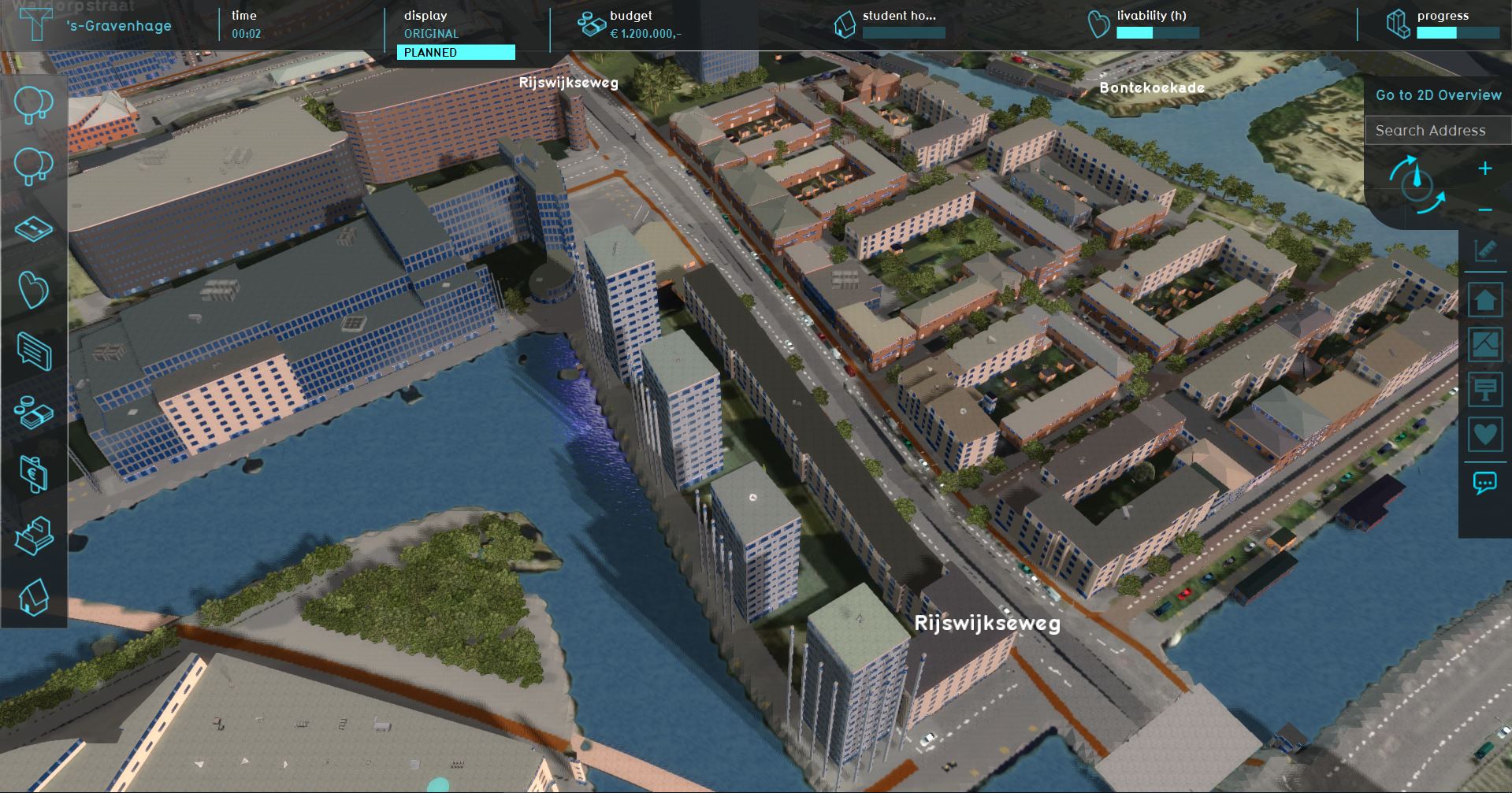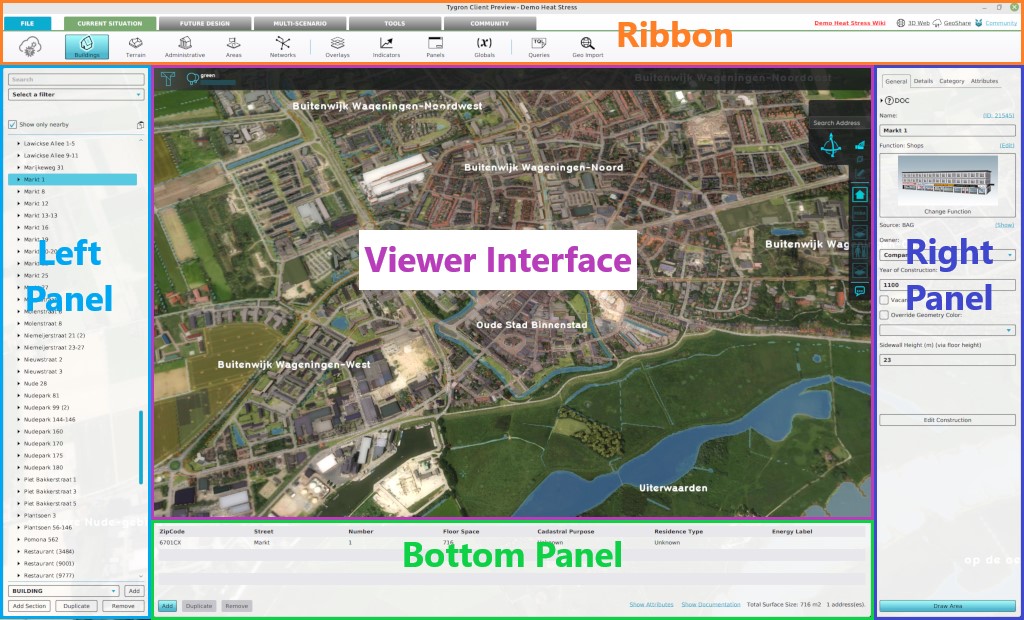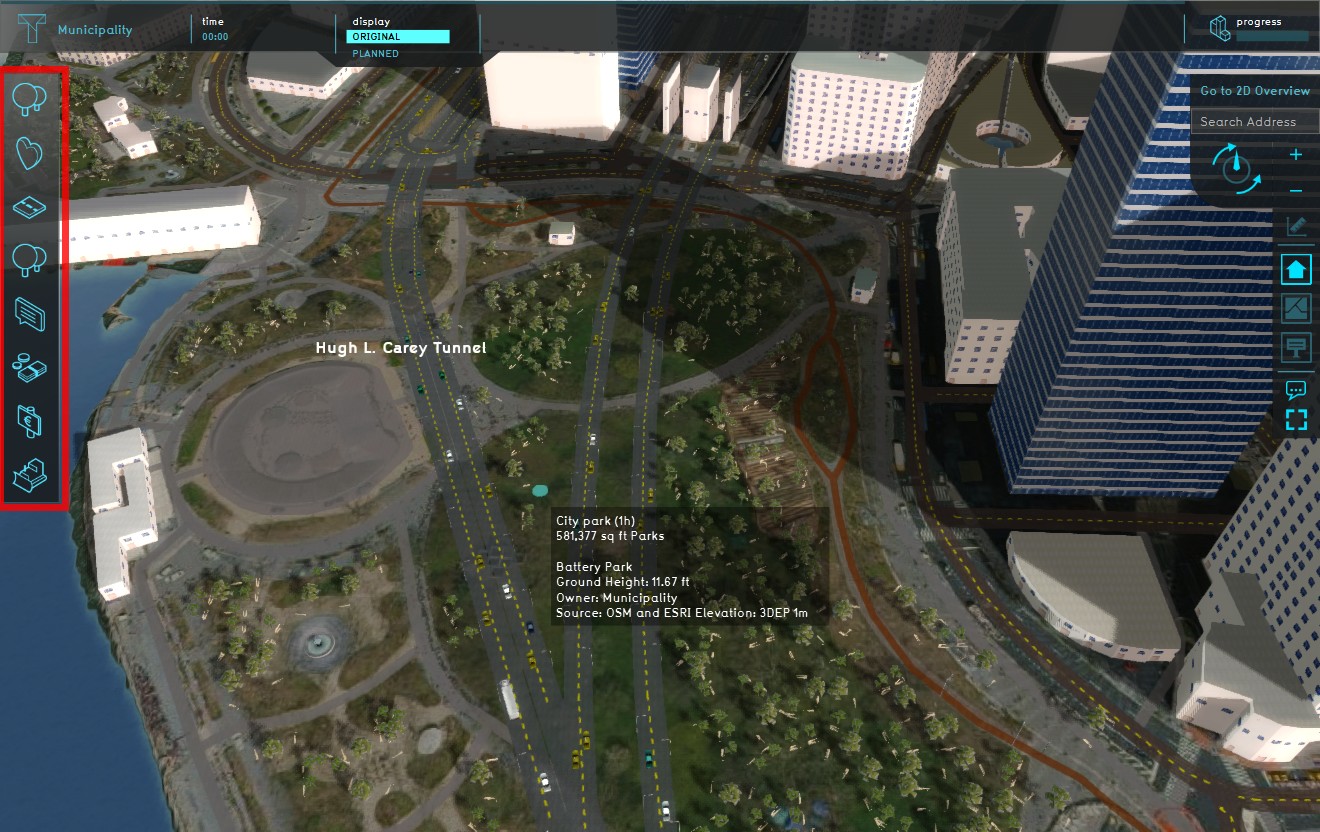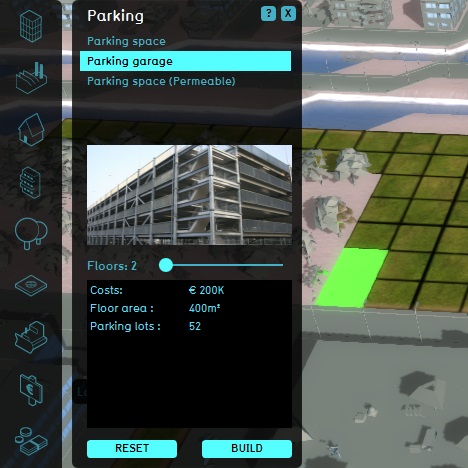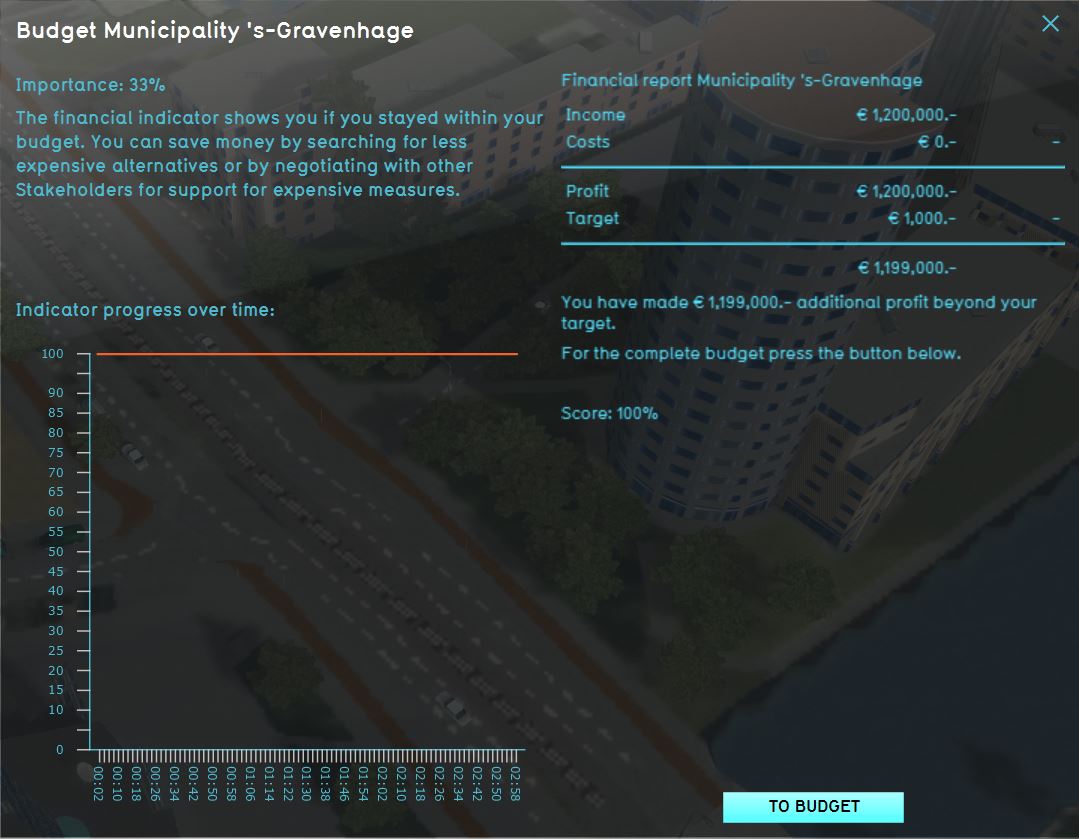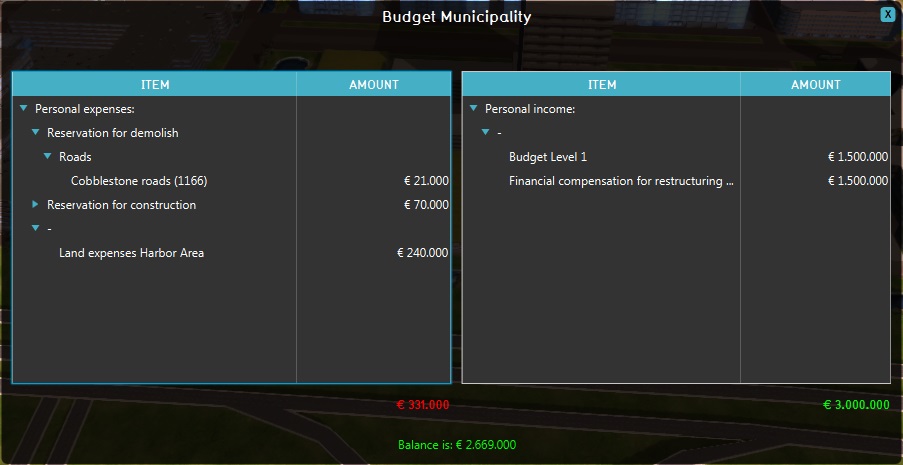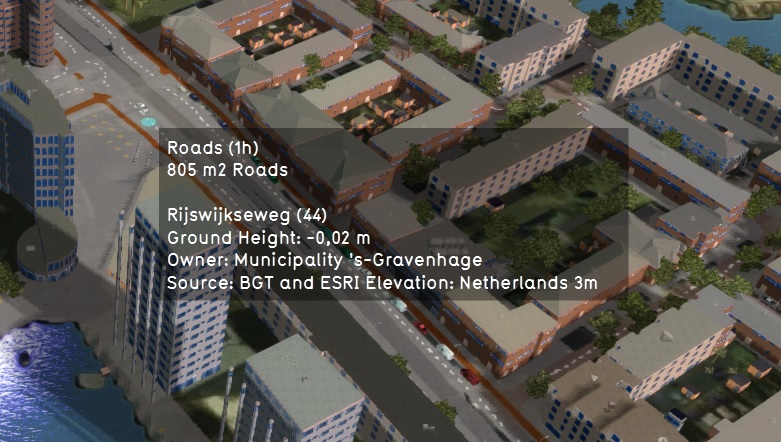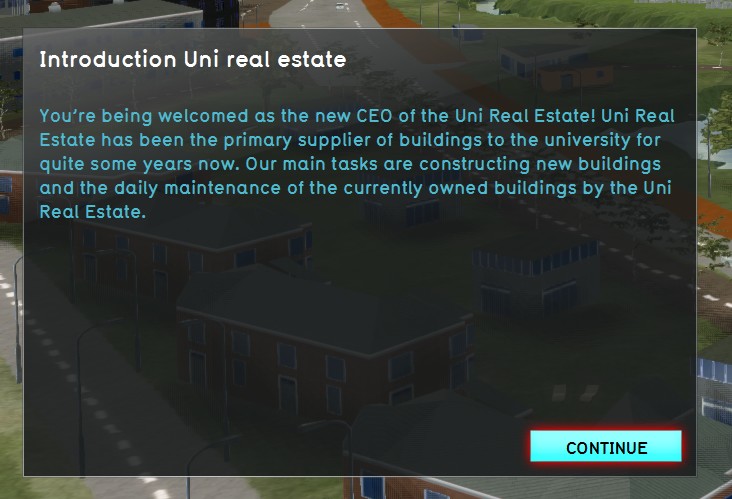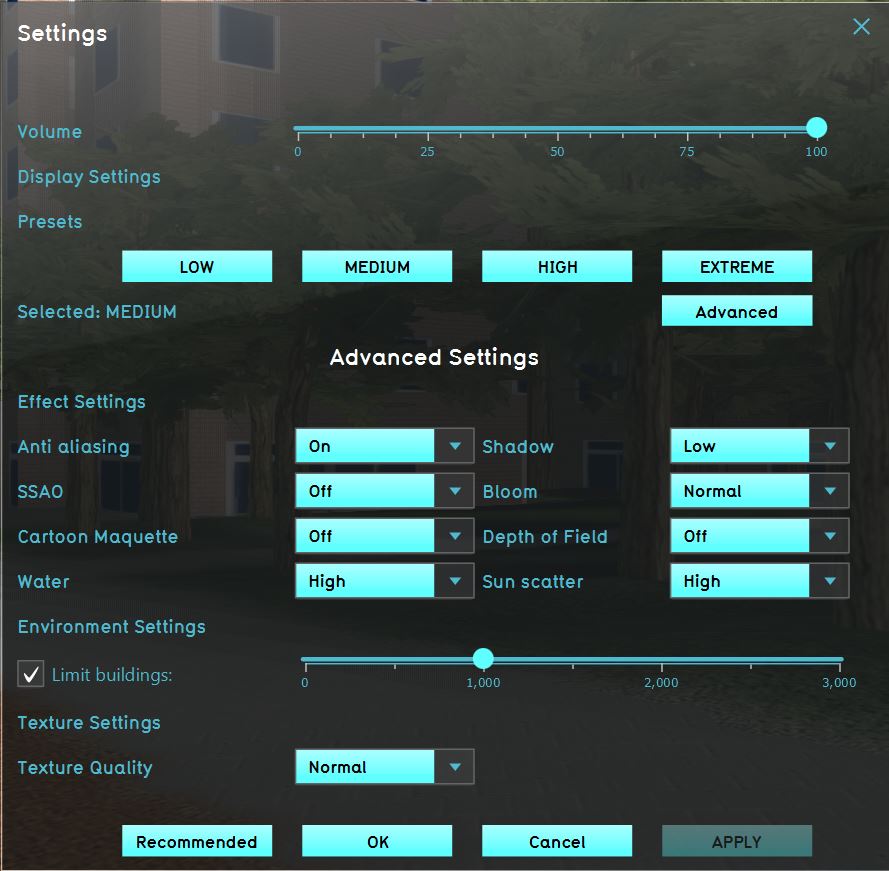Viewer
The main user interface allows end users to interact with the 3D Visualization, from the perspective of a stakeholder. It is rendered on top of the 3D Visualization and displays panels to inspect the Current and Planned situation of a project. It also contains panels that allow stakeholders to plan actions that will change the Planned situation.
To change the current situation of a project, users will have to user the Editor. The editor panels are added around the main interface, as shown in the image below.
Main interface elements
The Main Interface consists of the following elements:
- Top bar: Displays Indicators and buttons to switch between the Current and Planned situation.
The action menu is the list of icons on the left hand side of the screen. This menu contains actions available to a stakeholder. Clicking one of the icons, opens the action panel. In the action panel you can select a specific action.
Action panel
The action panel is the most important element to make changes to the 3D World. It's a versatile panel, since this panel can be used to create new buildings, demolish existing buildings, open panels to transfer money among others. Two main differences occur: Actions and Measures.
Actions
When taking an action, you need to select an area in the 3D World where to take the action. This is done using the cursor to "draw" a selection on the 3D World. Drawing is done by pointing the cursor at the 3D World, holding down the left mouse button, and releasing the mousebutton. If it's an action with configurable settings (such as the amount of floors for a building), an element will be provided to allow you to select a proper value.Making a selection is subject to validity. For more information on validity, please see Drawing validity.
Measures
When using a measure, you will simple be able to "apply" or "cancel" the action. A Measure is a predefined plan, implemented by the designer/ editor of the project.
Effects
When you have selected an action (and, if required, drawn a selection in the 3D World), the Top Bar will show the effects on the indicators for this stakeholder. Positive effects are noted green, while negative effects are marked red.
Exceptions
A few exceptions exist. One of the actions in the action menu may be the "Messages". When this action is selected, the message panel is opened. Financial actions, such as "Request subsidy" or "Finance View", open their own panels to provide information or continue interaction.
- Click on an icon to open the action panel.
- Select the action you wish to take in the action panel.
- If required, set the amount of floors using the slider in the action panel.
- If required, make a selection in the 3D World.
- Confirm the action by pressing the appropriate button on the action panel.
Address search
Located directly below the minimap is the address search bar. This search bar can be used to quickly navigate to a precise address in the 3D World.
- Click the address search bar
- Type in an address
- Autocomplete will try to complete the address
- Press the enter key to confirm
Additional interface elements
Besides the main interface elements described above, there are also a number of additional elements in the interface. These will appear and disappear depending on your interaction with the project.
Popups
- Main article: popups.
Popups are an important part of the interface, which are not immediately visible to the user. Instead, they appear whenever an action is taken, and input is required from the user concerning that action. This includes actions which the user takes themselves, but popups more often appear when other stakeholders take actions which the user in question must respond to. They also appear in the minimap in the form of exclamation marks.
Indicator panel
When you click on an indicator in the top bar, the indicator panel is opened. This panel displays information about the indicator you have selected. On the left side, at the top of the panel, is the name of the indicator, followed by its importance. A description of the indicator follows, to provide the user with information on what the indicator means, why it is important to the stakeholder and how to increase its score.
Under the "Explanation" heading, an overview displays the current score of the indicator, the target of the indicator, and the amount of progress which still needs to be made to score 100% on the indicator. The exact layout of this information differs per indicator.
On the right side of the panel, two graphs are visible. The top graph displays the total score on the indicator over time. The bottom graph displays the sub scores for the indicator over time. For example, in the case of the parking indicator, the bottom graph shows the amount of parking spaces per zone.
Progress panel
When you click on the progress indicator, located on the far right hand side in the top bar, the progress panel is opened. The left side of this panel displays the assignment for the stakeholder for the current level. The bottom bar on the left side displays the name of an indicator, followed by a bar presenting the current score of this indicator. The right side displays the description for the score of the shared indicators, and displays different colored bars, followed by the indicator names. The length of the bar represents the current scores of the shared indicators. On the bottom right it displays the total score as a percentage.
Budget panel
The budget panel can be accessed in two ways. You can open the indicator panel for your budget, and then press the button "To budget". Alternatively, when a finances category is available in the category panel, one of the available actions may be "Finance view". By selecting "Finance view, the budget panel is opened.
The budget panel displays an overview of your expenses and incomes. The left side of the panel displays the list of expenses. The expenses are collected in categories, which can be expanded by clicking the arrow next to a category. This displays all expenses within that category. At the bottom, in red, the total expenses are displayed. The right side of the panel displays the incomes in a similar fashion. Sources of income are categorized together, and can be expanded where desired to see what sources of income exist in a particular category. At the bottom, in green, the total amount of income is displayed.
At the bottom of the panel, the net balance is displayed. This is the amount of money the stakeholder has at that moment. The net balance is calculated by taking the total income and subtracting the total expenses from this value.
Message panel
The message panel can be opened by selecting the "Messages" category from the category panel. The message panel displays the messages received by this stakeholder from other stakeholders in the project area. When a message is selected from the panel, the message is opened in full. Some messages are informative only, and simply hold a textual message. Such messages can be confirmed and closed by pressing "OK" in the bottom right of the panel. This removes the message from the message panel. Other messages require a response. These have the options to "Keep" or "Respond". By selecting "Keep", the message is closed, but remains available in the message panel to respond to later. When you select "Respond", you are given the ability to select a response, and send it by selecting "Send". The message will then be removed from the message panel.
You can also select "New message" from the message panel. This allows you to send a message to a non-playable stakeholder. In the "New message" panel, select the stakeholder to whom you wish to send your message. Also provide a subject and the message itself. When you are ready to send your message, press "Send".
Legend
When drawing in the 3D World, or using an overlay other than the default overlay, a legend will be displayed at the bottom of the screen. Drawing in the world or activating an overlay will cause part or all of the world to be colored. The legend serves as a reference for which colors correspond to what information. For example, when viewing the ownership overlay, the legend will display which stakeholder is displayed with which color. When viewing the livability overlay, it provides a reminder of which colors indicate the most and least desirable values.
Hover panel
When you click the cursor still over any part of the project area, the hover panel will appear. The hover panel will display information about the area your cursor is pointing at, based on which overlay is currently active. By default, it display information about the:
- type of terrain;
- buildings
- address;
- owner;
- and data source.
Cinematic panel
Whenever text is displayed during a cinematic, it appears in the cinematic panel. While the cinematic panel is visible, the cinematic camera is paused. When you have read the text in the cinematic panel, you can click "continue" to close the cinematic panel and continue the cinematic.
The escape menu is opened by pressing the "Esc" key on your keyboard. The escape menu allows you to access the settings screen by pressing "Settings", and to display the credits by pressing "Credits". In single user and multi user sessions, you are also able to exit the session from this menu, by pressing "Exit". In single user sessions, you are also able to save the session state by pressing "Save".
Settings screen
The settings screen allows you to adjust the graphical settings of the Tygron Platform. By raising the values, you increase the graphical quality of the virtual environment. By lowering the values, you lower the stress on your hardware and thus increase performance. The settings panel offers four default settings: "Low", "Medium", "High" and "Full". Each of these options set the graphics to predefined values. By selecting "Advanced", you are also able to finely adjust which graphical settings to increase and decrease.
You can also adjust the volume by using the "Volume" slider.
